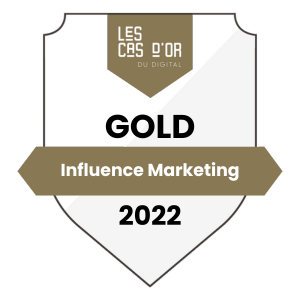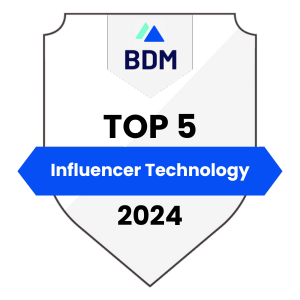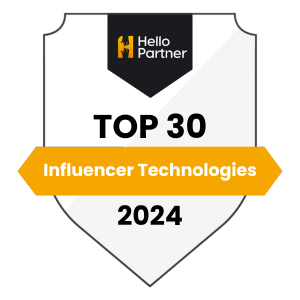Influencer marketing has grown at an impressive pace. In just a few years, it has gone from misunderstood and underestimated, to one of the most intriguing marketing strategies, taking a chunk of many brand’s digital marketing budgets.
As the rising influencer scene brings with it new opportunities, we can also expect new challenges, such as measuring KPIs with new technologies, complying with federal regulations, and identifying fake influencers, to name a few.
Our 2018 influencer trend predictions, combined with notes from other players in influencer marketing, will help you get to grips with the state of influencer affairs.
1. Influencer Marketing will become more competitive
At Stellar, we believe 2017 was a significant year for Influencer Marketing. It seems it is the year where brands finally ‘get’ it and the impact of influencer marketing on their bottom line.
The question “Should I do Influencer Marketing?” is now being replaced with “When should we start doing it?”, or “How can we get this right”?

If you’re still unconvinced, check out the chart above. Google Trends show a 100% increase in searches for the term “influencer marketing” from February 2013 to August 2017 for the category of Beauty & Fitness alone.
The reason behind this growing interest for Influencer Marketing is simple: It works. A Tomoson study proved that Influencer Marketing outperforms other marketing channels and is actually the fastest and most cost-effective customer acquisition method, generating an impressive $6.50 ROI for every $1 spent on influencer marketing.
It’s not surprising then that the part of the marketing budget dedicated to influencer marketing is growing. According to Linqia, 86% of marketers worked with influencers in 2017 with 92% of them finding it to be effective. 39% of respondents said they’re going to increase their spend, 44% declared they plan to use influencer content to boost other digital channels’ performances, and 36% will integrate influencer content with e-commerce to drive more sales.
With this in mind, fused with on our own strategies, we expect brands that have explored the influencer marketing space to invest more time, budget and energy into it in 2018.
2.Brands look for balance between Macro and Micro Influencers
Influencer Marketing was all about the ‘micro influencer’ in 2017. Our own Stellar campaign analytic reports show that brands got higher engagement rates than macro influencers on average.
Micro influencers also tend to be easier to approach and work with, and offer lower rates, representing a true cost-effective option. Among them are traditional social media influencers but also the best brand advocates, such as brand employees, customers or even social followers.
We believe that this trend will stay in 2018 as brands continue to opt collaborating with smaller ‘niche’ influencers.
Mediakix however predicts that 2018 will be “the year of integration”; that there will be a rise in combining top-tier and second-tier influencers. Depending on the brand’s DNA, budget and marketing objectives, different strategies, content channels and influencers profiles can be employed and combined.
3.Leveraging technology and data to measure KPI and ROI
As influencer marketing investment increases, collecting data to predict and measure performance becomes more vital.
One of biggest challenges for brands is gathering influencer information for better selection, since working with the right influencer is crucial in getting the right messages delivered to the right audience.
In addition, tracking Key Performance Indicators and Return on Investment using reliable data and technology can help brands make better decisions moving forward.
This whole process can be time consuming and complex, as most marketers still rely on manual work and spreadsheets when tracking results, or use multiple platforms to meet their various needs. These challenges will not disappear in 2018, especially as new influencers are born, web noise increases, and profiles become diversified.
Advisory firm IDC estimates that annual spending on martech solutions will exceed $32 billion this year.
Expect more platforms to offer insights on influencers’ content, audience reach, demographics, social analytics, and how an influencer campaign is resonating to the audience.
4.Instagram as an important network for influencer marketing
Instagram is today the most popular network for influencer marketing campaigns and this year it will rise even more.
In September 2017, Instagram announced that they reached a milestone of 800 million users. They are expected to exceed one billion users in 2018, and possibly reach $2 billion by 2019, according to Mediakix.
For brands to stand out from the crowd, they will need to focus on designing creative concepts, developing innovative strategies, and establishing substantial relationships with influencers to gain loyalty and beat the competition.
5.Video content becoming crucial
Probably the biggest influencer Marketing trend in 2018 is the use of video content on profile feeds, timelines, and stories sections. Not just because Cisco believes video consumption is expected to hit 80% of global online traffic by 2020, but because numbers continue to prove video superior effectiveness over other marketing channels.
According to a Social Media Today article, 86% of marketers currently use video content in online campaigns because key messaging is retained 95% more through video.
A study conducted jointly by gen.video and Geometry Global further reveal video would be twice as effective in driving sales as text-based ads, with more than 75% of respondents thinking video is more “enjoyable, relevant, believable and credible” than other types of content.
Influencers’ use of video will definitely have a big time in 2018. Influencers are becoming more skilled in video production, and not just YouTube.
Facebook, for instance, released an array of tools in late 2017 making it easier for everyone to create compelling videos.
6.Ephemeral content: the end of Snapchat and the boom of instagram stories?
One thing is sure: many social media predictions often happen to be wrong. 2017 was supposed to be the year of Snapchat, since the social platform gathered quickly a huge amount of users, generated a gigantic media buzz and launched a successful IPO.
Although Snapchat is of course still highly popular among the millennials, the platform hasn’t become the huge hit some had predicted. Enthusiasm from both brands and influencers have shifted from Snap to Insta and our recent clients’ reports showed for instance that top macro influencers are posting more on Instagram Stories and shy away from Snapchat Stories.
This reminds us as digital marketers how inconsistent the social media landscape can be, and that all social users can always change their habits and preferences and certainly refuse to be told what to do.
7.The Hunt of “Fake” influencers is open
With only a few euros, anyone can easily get thousands of followers. This creates a new generation of “fake” influencers who collected huge audience, not thanks to their hard work but their wallet.
This can be a tough and expensive lesson to learn for brands that still believe the size of an audience account is the most important factor that determines its level of influence.
Given the rise of smaller and lesser-known content creators, we can safely assume that the number of want-to-be influencers will increase, despite restrictions launched by social networks themselves.
To ensure your budget is being spent correctly, brands can either work with companies that have strong relationships with influencers and demonstrated expertise in the industry.
Alternatively, brands can rely on automated tools that instantly identify fake accounts in just a few seconds.
8.More regulations for influencers and brands?
With the increasing use of influencer marketing campaigns and collaborations, the US Federal Trade Commission (FTC) had no choice but to introduce some rules, which was later imitated by European bodies. For the first time in 2017, FTC filed a case against different influencers who failed to disclose paid sponsorship promotions and has recently opened compliances issues against 90 influencers and marketers.
With up to 90% of paid endorsements still remaining undisclosed – either because rules are unknown or because some are afraid to disappoint their audience by not being seen as authentic content creator – a lot of Influencer Marketing experts expect lawsuits against influencers and the brands working with them will increase in 2018 especially in the US region.









